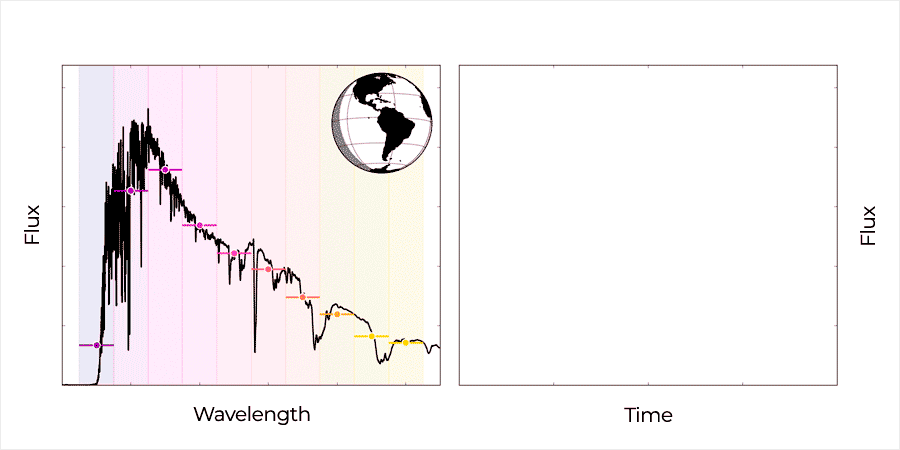Numerous tools will appear in the coming decades, and several missions will be launched that may be able to detect oceans of water and possibly life on distant planets, including NASA space observatories James Webb, Large UV Optical Infrared Surveyor, Origins Space Telescope, Habitable Exoplanet Observatory and others. But what will its signs look like and what is needed in order to actually reliably determine the biosignature? These are two key issues that astronomers face when choosing and designing future space telescopes.
Considering that while we have only one example of life in the Universe, the thermal and chemical properties of the Earth must be inherent in an exoplanet in order to be considered potentially habitable. One of the main ways to determine this is to explore and model the composition and atmosphere of the extrasolar world, which will give an idea of the climate prevailing in it.
Today, astronomers can get a lot of information about the atmosphere of exoplanets using spectroscopy, which allows them to determine, for example, which molecules are present in the gas envelope and whether clouds and haze are characteristic of it, which ultimately gives additional clues about surface temperature and much more.
Current research has focused on detecting water, oxygen and other compounds in the atmosphere that signal the potential habitability of an exoplanet. However, spectroscopy allows you to see only the uppermost layers of its shell, and this is not very productive for finding water, given that on Earth, all water vapor is concentrated in the lower layers of the atmosphere. Therefore, in our work, we focused on another way to search for water and in another place – on the surface of an exoplanet.
But why look for the oceans? Everything is simple – water is one of the key links of life known to us, and a large number of it may be one of the most unambiguous indicators of the exoplanet habitability.
How to see the ocean of the extrasolar world?
Since the exoplanet rotates around its axis, our telescopes from time to time see different parts of its surface – sometimes plains and mountains, and sometimes seas and oceans, and this changes the overall spectrum of the purpose of the observation and its albedo.
In addition, as the star envelops its surface, the surface of the extrasolar world is illuminated differently, it is similar to the phases of the moon. And, although the technique available to us today cannot directly consider the landscape of an exoplanet, it can still give an idea of how reflective each slice of its surface is.
Given that the ocean is more reflective than land, the light curve of an exoplanet can reveal where water is on its surface and where it is not. In addition, the oceans, when viewed from an acute angle, can create glare. The NASA Galileo spacecraft, performing a gravitational maneuver near the Earth, observed this phenomenon, which is more clearly manifested in the sickle-shaped phases. Interestingly, the glare is not unique to water reservoirs, and they can also be observed for hydrocarbon seas, covering, for example, Titan.
What telescopes can see these signals?
To find out what characteristics a tool must have that can detect evidence of the presence of oceans on the surface of the extrasolar world, the authors of the study used the atmospheric model based on the Earth’s observations by NASA EPOXI. She helped them imagine Earth as an Exoplanet, observed at a distance of about 16 light years using a telescope, similar to those that are being prepared for launch.
Our simulations have shown that, although detecting oceans is likely to be too difficult for James Webb, the next generation of space telescopes with a mirror diameter of 6 to 15 meters, for example, Large UV Optical Infrared Surveyor , should be in able to do that.
The exact number of exoplanets discovered with oceans depends on how common they are. Based on the currently available, albeit limited data set, astronomers estimate that about 20 percent of the stars may have habitable Earth-like planets. Based on this, according to the authors of the work, future space telescopes should detect up to 10 exoplanets in the habitable zones of nearby stars whose surfaces are covered with oceans.
The discovery of the oceans or life on exoplanets is a big technical problem and it will remain in the near future, but the solution to this problem is an excellent opportunity to finally answer the fundamental questions: are there any planets like the Earth, and are we alone in the Universe. The proposed method will become one of the useful tools for an unambiguous assessment of the potential for habitability of extrasolar worlds.
How to find an exoplanet with oceans of water
Click To Tweet
The post How to find an exoplanet with oceans of water? appeared first on Upcosmos.com.
